#sutra of lotus
Note
Hi! First off your blog is such an important resource for me in kimono patterns, thank you for keeping it! Secondly, a question. What patterns are associated with death? I know of spider lilies, and pure black kimono accessories for funeral wear, but otherwise not much else. I suspect that kind of pattern would be more of a novelty item print than an estabilished and used pattern.
Hi and thanks for your kinds words! Off the top of my head, they are several patterns associated with death, mostly linked to Buddhism.
Tbh, mourning attire for women are for me more an affair of colors (black/muted) and discreet not-celebratory patterns (it also depends of ones means). Novelty "death-themed"patterns are more and more present in modern kimono, yet you can also find "traditional" ones - even if they are on the rarer side.
Formal mourning garb, as you note, asks for mofuku (black kimono and obi with a few white accessories). Obi usually have very traditional woven ground patterns - for example ryuusui (running water) which kinda symbolize "the flow of life".
For the Buddhist anniversary of one's death and rememberance services, ladies would (when they can afford it) go from all black to half-mourning dress in muted colors like dull greys or ashen purple. For such occasions, you can find Buddhist patterns like sutra (Heart sutra especially), lotus flowers, gorintô (stylized stupa), etc.
More seasonal items could reference Buddhist Obon (festival of the dead) or Higan (more especially autumn equinox Shûbun), but such patterns for very specific events are on the rarer side, and more a matter of taste and style.
Patterns can include higanbana (spider lilies) for Higan, and for Obon: lanterns, cucumber or eggplant "spirit horse", hozuki (ground cherry), nod to Kyoto’s Daimonji kanji, or memento mori-themed motifs (like skeletons, nozarashi or graveplates).
As a step further into morbid imagery, another pattern which can sometimes be found, especially on men juban or haori lining, are decaying corpses (referencing Buddhist meditation on kusôzu or "nine stages of decay"). This was a subject in Japanese art, you can find an example here (cw: corpse depiction).
Hinting at Buddhist concept of impermanence and search for enlightment, Hell courtesan (jigoku dayû) with uchikake coats depicting hellish torments could also enter the death patterns category. Same goes for Buddhist hell imagery of Hell king Enma, or Hell guardians Gozu and Mezu (I believe I saw them on men juban/haori linings + on netsuke).
Finally, because we are talking of death, have a look at this super unsual and puzzling kimono depicting butsunehan (death of Buddha). Becky Mitsui's article is a wild ride xD
#ask#japanese patterns#kimono#obi#death#death imagery#mourning#obon#higan#buddhism#mofuku#heart sutra#skeleton#skull#nozarashi#graveplates#itatoba#sotoba#lotus#higanbana#spider lily#kusozu#nine stages of decay#jigoku daiyu#hell courtesan#Enma#jigoku#Gozu and Mezu#butsunehan#death of Buddha
124 notes
·
View notes
Photo
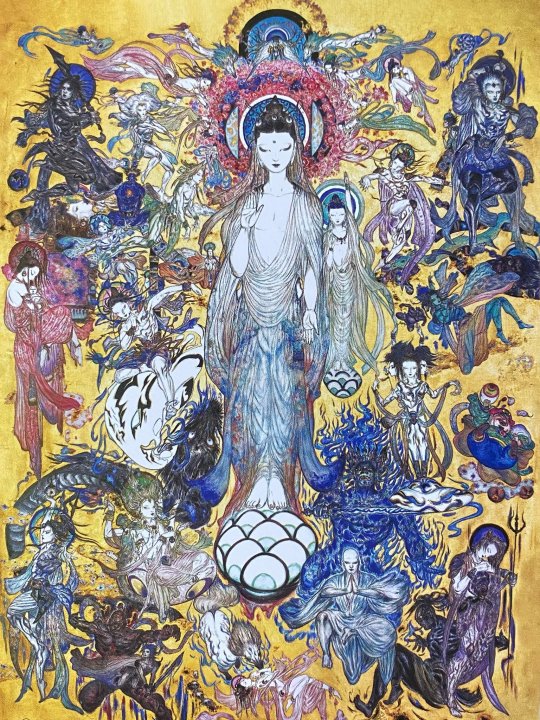
A higher res version of Yoshitaka Amano’s Lotus Sutra, thanks to tomorrowitcouldbeyou!
1K notes
·
View notes
Text
Good Source for Trans Monkey King Headcanon
While Sun Wukong is not historically or canonically transgender, I wholeheartedly support anyone with a headcanon portraying him as such. A great example of spiritual gender transition from Buddhist scripture that could serve as a basis for your headcanon is the “Dragon Girl” (Longnu, 龍女) from chapter 12 of the Lotus Sutra (Miaofa lianhua jing, 妙法蓮華經; a.k.a. Fahua jing, 法華經, c. 3rd-century).
She is first introduced to an assembly of Buddhist deities as the eight-year old daughter of the Dragon King Sāgara (Suojieluo longwang, 娑竭羅龍王) and one of an unfathomable number of dragonfolk enlightened by the Bodhisattva Mañjuśrī’s (Wenshu shili, 文殊師利) lessons on the Lotus Sutra. Her teacher describes her as a great student prodigy with a deep knowledge of Buddhist Law, as well as having many advanced spiritual achievements. But this upsets some among the assembly because the notion of a young girl approaching Buddhahood so quickly flies in the face of convention, which normally calls for untold aeons of severe austerities before one can achieve awakening. Her accomplishments are called into question at first, but everyone is appeased when she offers a priceless jewel to the Buddha, and he quickly accepts it as a symbolic gesture. Then:
The girl said [to the assembly], “Employ your supernatural powers and watch me attain Buddhahood. It will be even quicker than that!”
At that time the members of the assembly all saw the dragon girl in the space of an instant change into a man (emphasis added) and carry out all the practices of a bodhisattva, immediately proceeding to the spotless World of the south, taking a seat on a jeweled lotus, and attaining impartial and correct enlightenment. With the thirty-two features and the eighty characteristics [of a Buddha], he expounded the wonderful Law for all living beings everywhere in the ten directions (Watson, 1993, p. 188). [1]
女言:「以汝神力,觀我成佛,復速於此。」
當時眾會,皆見龍女忽然之間變成男子,具菩薩行,即往南方無垢世界,坐寶蓮華,成等正覺,三十二相、八十種好,普為十方一切眾生演說妙法。
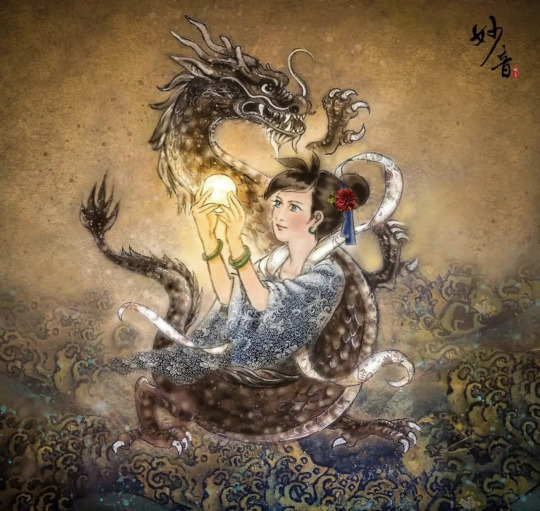
A drawing of the Dragon Girl and the priceless jewel (larger version). Image found here.
Note:
1) For the Dragon Girl’s story, see Watson, 1993, pp. 187-189.
Source:
Watson, B. (Trans.) (1993). The Lotus Sutra. New York: Columbia University Press.
#Dragon Girl#Longnu#Lotus Sutra#trans#Monkeey King#Sun Wukong#trans Sun Wukong#trans Monkey King#Lego Monkie Kid#LMK#Journey to the West#JTTW#headcanon
148 notes
·
View notes
Photo

Lotus Sutra / late 12th century/ Japanese
Opening with an illustration, this handscroll of the Lotus Sutra was part of a larger body of work copied or commissioned by members of the court as a means to salvation. The indigo color stands for the mineral lapis lazuli, which, like gold and silver, is part of the seven treasures of Buddhism. Illuminated sutras are believed to have been dedicated by the Fujiwara clan to Chusonji Temple in the northeast region of Japan.
Handscroll; gold and silver on indigo dyed paper, 3940 15/16 × 9 3/4 in. (10010 × 24.8 cm); width with knobs: 11 1/2 in. (29.2 cm)
Seattle Art Museum
122 notes
·
View notes
Text
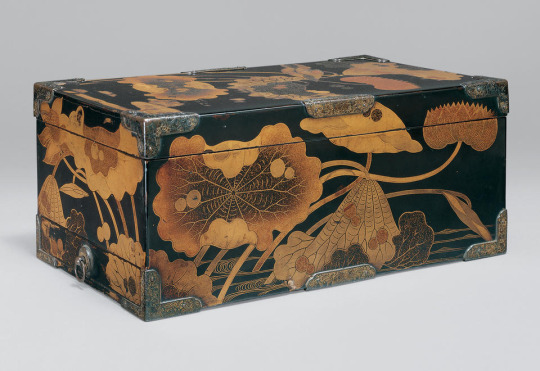
Sutra Box (Kyōbako) with Lotus Pond
Edo period (1615–1868)
early 17th century, Japan
Lacquered wood with gold togidashi maki-e, hiramaki-e, and e-nashiji (“pear-skin picture”)
SOURCE: The Met
12 notes
·
View notes
Text
Make Your Own Buddhist Sutra Book
Lately I’ve been talking a lot about home Buddhist practice, including home Buddhist services and such. These are things that devour lay-Buddhists often do (myself included), but then I realized I never talked about making one’s own sutra book.
There are a couple reasons why one might make their own…

View On WordPress
5 notes
·
View notes
Text

In the Lotus Sutra, Buddha says to light up one corner—not the whole world. Just make it clear where you are.
— Shunryū Suzuki
105 notes
·
View notes
Text

Excerpt from the Lotus Sutra, chapter 16, in Kanbun Kundoku, a kind of creole language, a mixture of Classical Chinese and Classical Japanese into one language.
#lotus sutra#buddhist#buddhism#japan#japanese#classical japanese#classical chinese#chinese#kanji#kanbun#kanbun kundoku#creole#artificial language#linguistics#constructed language
5 notes
·
View notes
Photo
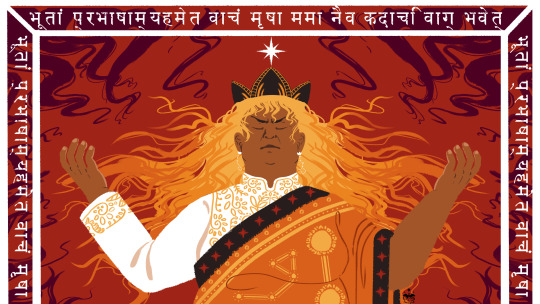

“If someone does not want me it is not the end of the world.
But if I do not want me, the world is nothing but endings.”
#touhou#2hu#okina matara#my art#art by op#yeah this is vent art that's why it's a little sloppy#the sanskrit text was supposed to be a line from the Lotus Sutra saying:#You should now awaken the power of faith And with perseverance abide in the good.#but in sanskrit these lines are translated completely differently so it only means that in spirit#I wanted to make the background not be obviously distinguishable from Okina's hair#something something and the universe said you are the universe tasting itself talking to itself reading its own code
82 notes
·
View notes
Photo

The frontispiece to the first fascicle of the Lotus Sutra depicting the Buddha Shakyamuni (釈迦如来 Shaka Nyorai) preaching at Vulture Peak attended by bodhisattvas, arhats, and layfolks
From a manuscript of the sutra dating to the 11th century in the collection of Enryakuji Temple (延暦寺) on Mount Hiei (比叡山) north of Kyoto
Image from “Paintings of the Lotus Sutra” by Willa J. Tanabe, Weatherhill, 1988, plate 28
#japanese art#buddhist art#buddhist literature#sutra#妙法蓮華経#myoho rengekyo#法華経#法華經#hokkekyo#lotus sutra#釈迦如来#shaka nyorai#shakyamuni#shakyamuni buddha#frontispiece#book illustration#illuminated manuscript#illuminated texts#滋賀県#shiga prefecture#大津市#otsu#比叡山#hieizan#mount hiei#延暦寺#enryakuji#天台宗#tendai
59 notes
·
View notes
Text
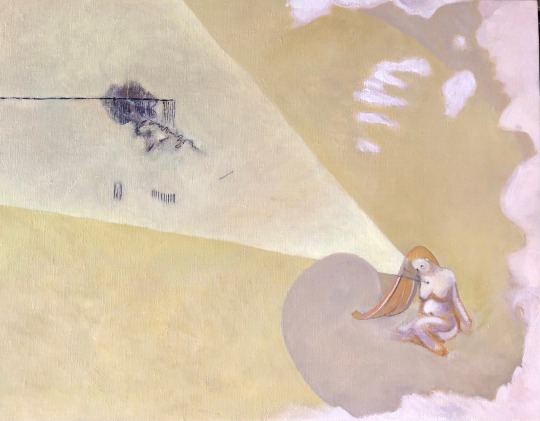
"TONZURA of The Devil King of the Sixth Heaven"
(第六天の魔王のトンズラ(天子魔のトンズラ)
oil on canvas
530×410mm
2023
この作品は、前作である「天子魔の出現」の連作です。
「天子魔(別目:大六天の魔王)」が、女性の心から退散した場面を表現しています。
「大六天の魔王」とは、法華経に説かれており、様々な働きがありますが、その一つに〝美しい心の自分を潰そうとする、もう一つの自分の心“として現れる現象です。
生きていると、あらゆるシチュエーションで、試される時があります。私自身、自分の良心を奪おうとする、もう一つの自分が出てくる時もあるので、心の中で魔がトンズラして遠くに消えていくことを潜在的に望んでいたから、この絵が心の中にフッと浮かんだのだろうと思っています。
また、不吉な予感がする前作の「天子魔の出現」が、ハッピーな方向を向いていくようにという思いから浮かんだのだと思っています。
This work is a continuation of the previous work, “Appearance of the hindrance of the devil king”(another name: Devil King of the Sixth Heaven)'' expresses a scene where a woman has seriously retreated.
The ” Devil King of the Sixth Heaven'' is described in the Lotus Sutra, and has various functions, one of which is a phenomenon that appears as ”another self that destroys the beautiful heart of oneself.''
In life, there are times when you will be tested by all kinds of problems.
For me, there are times when another version of myself comes out trying to take away my conscience, so I was subconsciously thinking that the devil would twist around in my heart and disappear into the distance, so this picture touched my heart. I wonder if it just popped into my head.
Also I think the previous work, ``The hindrance of the devil king,'' which had an eerie atmosphere, came about because of the desire for Happy to move in the same direction.

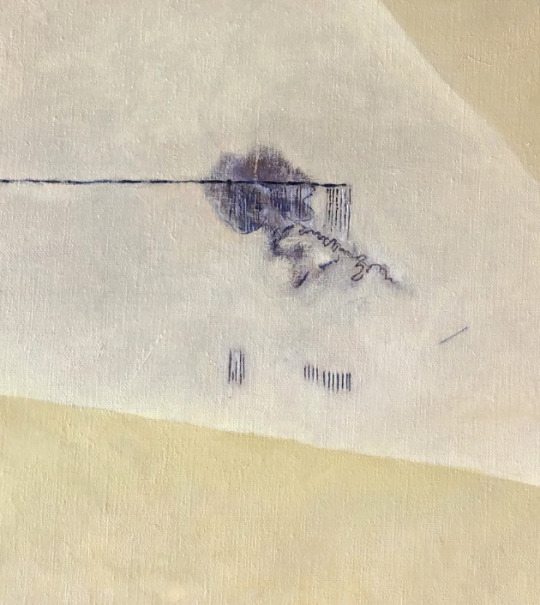
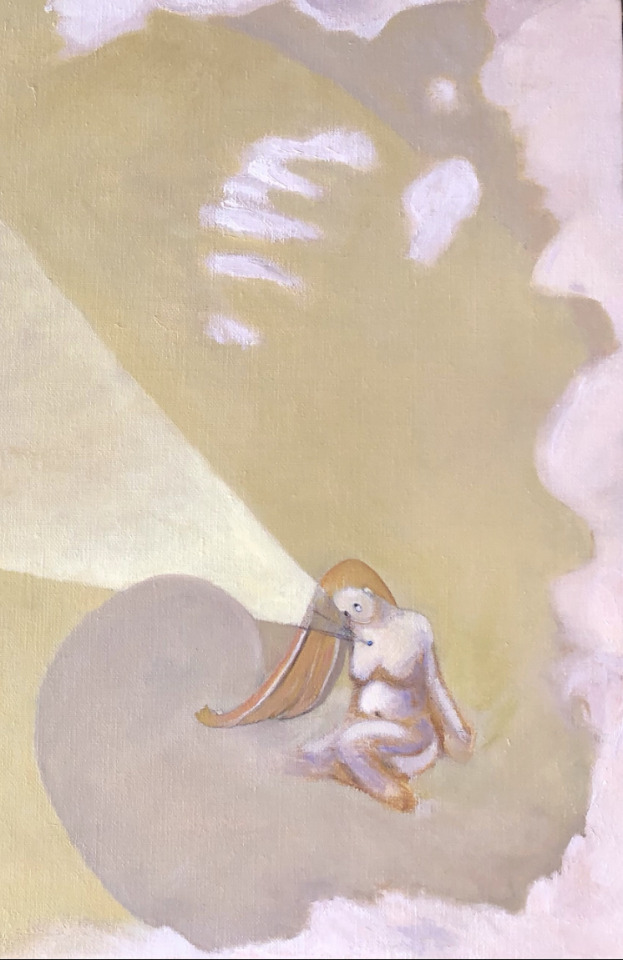
2 notes
·
View notes
Text
Very much in love with my new copy of the Lotus Sutra. And I think I can agree that this one is the English translation to go for. Yay to more study materials!
#religious ramblings#lotus sutra#religious books#sacred texts#mahayana buddhism#buddhist witch#asian witch
15 notes
·
View notes
Note
Have you seen Amano's Lotus Sutra illustration? Those are some SMT-esque mythical figures right there.
I have not.
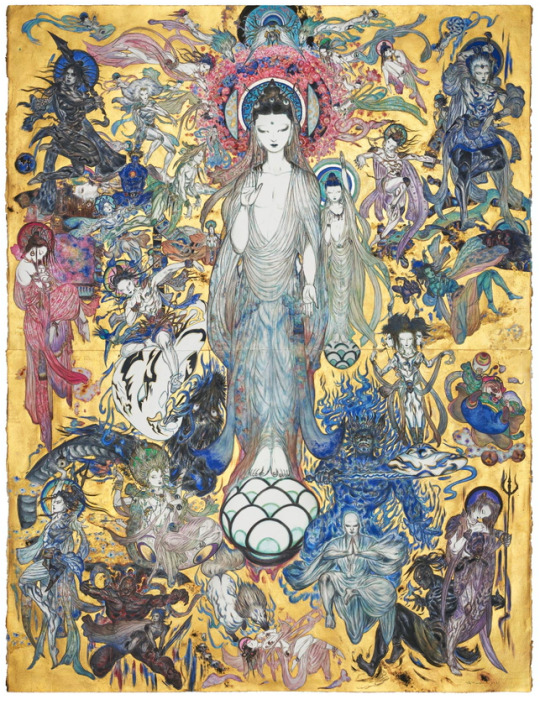
This is fantastic and I wish I could find a larger version! I love when Amano uses a gold background. But I still don't think you could plop any of these directly into SMT without some adaptation (take what looks to be Kannon in the center, identifiable but PURE Amano).
37 notes
·
View notes
Text

I went to my local Nichiren Shu temple for the first time and I think I’ve found my sangha 🙏
15 notes
·
View notes
Text
There is No Buddha-Dharma Outside the Mind, by Harada Sekkei Roshi
There is No Buddha-Dharma Outside the Mind, by Harada Sekkei Roshi http://wp.me/pFy3u-2J2
At the beginning of Keizan Jokin Daishi’s Zazen Yojinki, there is the teaching ‘Zazen directly lets people illumine the mind and rest peacefully in their fundamental endowment.’ In Eihei Dogen Zenji’s Fukanza-zengi, we can find this same teaching expressed as `When you seek the Way, it is found to be essentially universal and complete. How, then, can it be contingent upon practice and…

View On WordPress
3 notes
·
View notes
